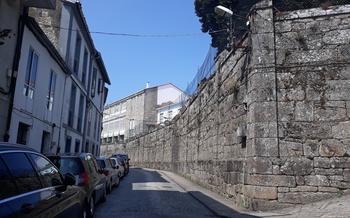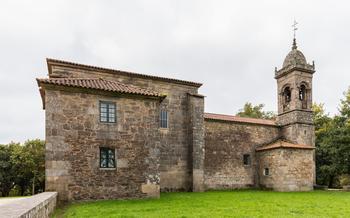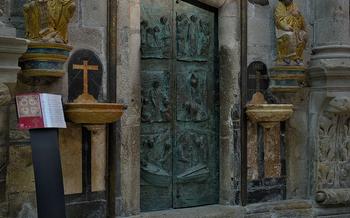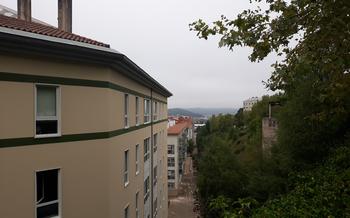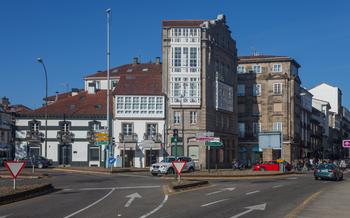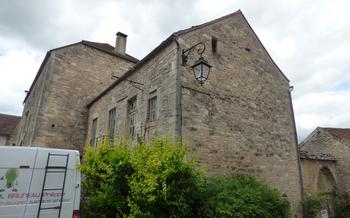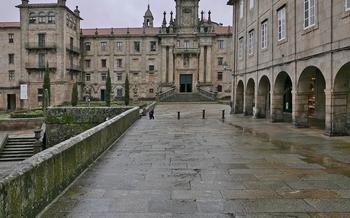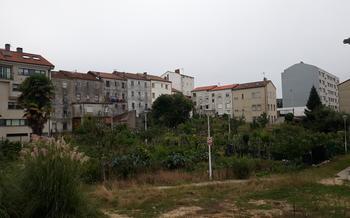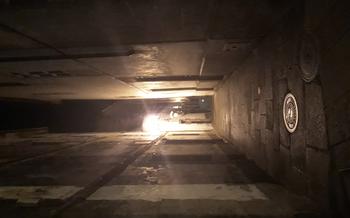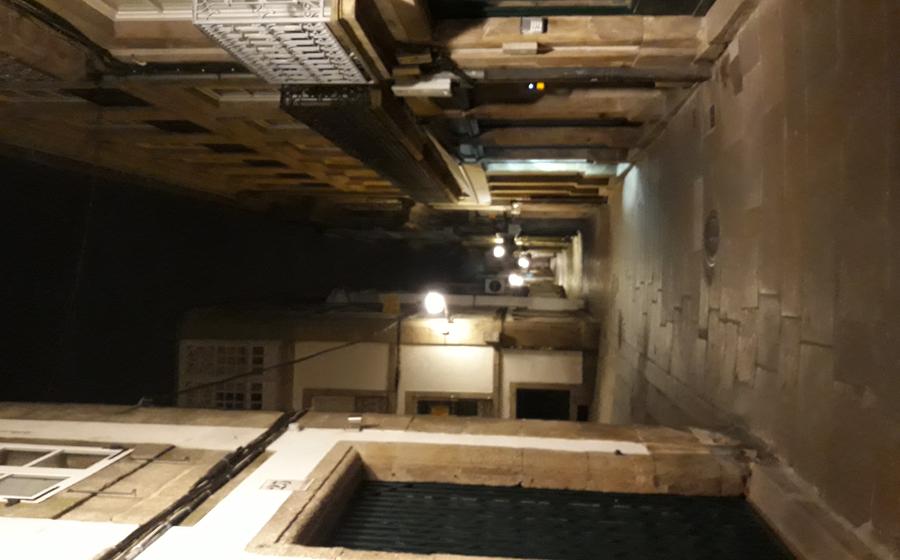
Praza de la Inmaculada Square with monastic buildings
- Praza de la Inmaculada Square: A Place of History and Beauty
- Monastery of San Martiño Pinario: A Majestic Benedictine Abbey
- History and Founding
- Architectural Highlights
- Notable Works of Art and Religious Significance
- Visiting Information
- Cathedral of Santiago de Compostela: A Pilgrimage Destination
- Colegio de San Xerome: A Renaissance Masterpiece
- Hostal dos Reis Católicos: A Historic Landmark
- Plaza de Platerías: A Lively Square with History
- Casa do Cabido: A Historic Building with a Unique Purpose
- Pazo de Raxoi: The City Hall of Santiago
- Mercado de Abastos: A Vibrant Marketplace
- Plaza Quintana: A Historic Square with a Fountain
- Museo do Pobo Galego: Exploring Galician Culture
- Practical Information
- Rúa do Franco: A Historic Street with Charm
Praza de la Inmaculada Square: A Place of History and Beauty
Praza de la Inmaculada, also known as Obradoiro Square, is the heart of Santiago de Compostela and a testament to the city's rich history and stunning architecture. Surrounded by a cluster of monastic buildings, this awe-inspiring square stands as a symbol of faith, culture, and architectural mastery.
The square's historical roots date back to the Middle Ages when it served as a gathering place for pilgrims embarking on the Camino de Santiago, a renowned pilgrimage route leading to the Cathedral of Santiago de Compostela. Over time, the square evolved into a thriving center of religious and cultural activity, with the construction of magnificent monastic buildings that shaped its current architectural landscape.
Among the architectural highlights of the square is the Monastery of San Martiño Pinario, a Benedictine abbey that exudes grandeur and historical significance. The Cathedral of Santiago de Compostela, a UNESCO World Heritage Site and the final destination of the Camino de Santiago, dominates the square with its imposing presence and intricate Gothic architecture.
Praza de la Inmaculada is not merely a historical site; it's a place that pulsates with life and cultural significance. Throughout the year, the square hosts various events, concerts, and performances, showcasing the city's vibrant arts scene. Its lively atmosphere, coupled with the stunning backdrop of the monastic buildings, creates an unforgettable experience for visitors from all corners of the globe.
To fully immerse yourself in the essence of Praza de la Inmaculada, take time to stroll through its cobblestone streets, admire the intricate facades of the monastic buildings, and soak in the vibrant atmosphere. Whether you're a history buff, an architecture enthusiast, or simply seeking a place to marvel at the beauty of Santiago de Compostela, Praza de la Inmaculada is an absolute must-visit.
Monastery of San Martiño Pinario: A Majestic Benedictine Abbey
Nestled within the historic heart of Santiago de Compostela, the Monastery of San Martiño Pinario stands as a testament to architectural grandeur and religious devotion. Founded in the 10th century as a Benedictine monastery, this majestic abbey has played a pivotal role in the city's spiritual and cultural landscape throughout the centuries.
History and Founding
The origins of the Monastery of San Martiño Pinario are intertwined with the legend of Saint Martin, a former Roman soldier who dedicated his life to serving the poor and the sick. In the 6th century, Saint Martin's relics were brought to Santiago de Compostela, where they became a source of veneration and pilgrimage. Inspired by the saint's legacy, a group of Benedictine monks established the monastery in the 10th century to honor his memory and provide shelter to pilgrims on the Camino de Santiago.
Architectural Highlights
The monastery's architectural grandeur reflects the blending of Romanesque and Gothic styles, showcasing the evolution of architectural trends in medieval Spain. Its imposing facade features an intricate portal adorned with biblical scenes and sculptures of saints, inviting visitors into a realm of sacred beauty. Inside, the monastery's vast interior reveals a harmonious blend of Romanesque and Gothic elements, with soaring vaults, ribbed arches, and intricate carvings that captivate the senses.
Notable Works of Art and Religious Significance
Beyond its architectural splendor, the Monastery of San Martiño Pinario houses a treasure trove of religious art and artifacts. The monastery's main altarpiece, crafted in the 18th century, is a masterpiece of Baroque art, depicting scenes from the life of Saint Martin and the Virgin Mary. The monastery's cloister, with its serene arcades and delicate tracery, provides a contemplative sanctuary for visitors to reflect and connect with the divine.
Visiting Information
The Monastery of San Martiño Pinario is a must-visit destination for anyone seeking to immerse themselves in the spiritual and cultural heritage of Santiago de Compostela. Visitors can marvel at its architectural beauty, admire its sacred art, and experience the tranquility of its cloister. Guided tours are available to provide insights into the monastery's history, architecture, and religious significance.
Cathedral of Santiago de Compostela: A Pilgrimage Destination
The majestic Cathedral of Santiago de Compostela, a UNESCO World Heritage Site, stands as a testament to the city's profound religious significance. Its history is deeply intertwined with the pilgrimage tradition of the Camino de Santiago, which has drawn countless pilgrims from across Europe for centuries.
The cathedral's awe-inspiring architecture, characterized by a blend of Romanesque and Gothic styles, showcases intricate carvings, grand spires, and a magnificent facade adorned with biblical scenes. Inside, visitors are captivated by the grandeur of the nave, the intricate details of the choir stalls, and the stunning stained glass windows that bathe the interior in a kaleidoscope of colors.
The cathedral's most sacred relic, the remains of St. James the Great, are enshrined in a silver urn beneath the main altar, attracting devoted pilgrims who come to pay homage and seek spiritual renewal. The awe-inspiring Botafumeiro, a giant thurible, swings ceremoniously during special occasions, filling the cathedral with the sweet scent of incense and adding to the sense of wonder and devotion.
Visiting the Cathedral of Santiago de Compostela is a profound experience that transcends religious affiliation, inviting visitors to immerse themselves in the history, culture, and spirituality that have shaped this sacred site for centuries.
Colegio de San Xerome: A Renaissance Masterpiece
The Colegio de San Xerome, located in the Praza do Obradoiro, is a stunning example of Renaissance architecture and a significant cultural landmark in Santiago de Compostela. Founded in 1501 by Archbishop Fernando de Fonseca, the college was intended to provide education and accommodation for students of theology and philosophy.
The architectural style of the Colegio de San Xerome is a blend of Gothic and Renaissance elements, showcasing the transition between the two periods. The main facade features intricate carvings, decorative moldings, and large windows that flood the interior with natural light. The central courtyard, with its elegant arcades and balconies, is a testament to the harmonious fusion of architectural styles.
Inside the college, visitors can admire the beautifully preserved cloister, which features a series of arches supported by slender columns. The cloister is adorned with intricate carvings and sculptures, reflecting the artistic sensibilities of the Renaissance era. The college also boasts a remarkable collection of paintings, sculptures, and tapestries, contributing to its reputation as a center of artistic and cultural excellence.
The Colegio de San Xerome played a crucial role in the intellectual and religious development of Santiago de Compostela. It was one of the first institutions in Spain to offer humanistic studies, emphasizing the study of classical languages and literature. Notable scholars and theologians taught at the college, contributing to the city's reputation as a center of learning and scholarship.
Today, the Colegio de San Xerome continues to be a vibrant cultural institution. It houses the Museo del Pueblo Gallego, which showcases the history, culture, and traditions of Galicia. The museum's exhibits include a collection of archaeological artifacts, traditional costumes, and works of art that provide a glimpse into the rich heritage of the region.
Visiting hours for the Colegio de San Xerome and the Museo del Pueblo Gallego vary depending on the time of year. It is recommended to check the official website or contact the institution for specific opening hours. Admission fees are typically charged, but reduced rates or free admission may be available for students, seniors, and groups.
Hostal dos Reis Católicos: A Historic Landmark
The Hostal dos Reis Católicos stands as a testament to the rich history of Santiago de Compostela. Founded in the 15th century by the Catholic Monarchs, Ferdinand and Isabella, this magnificent building was initially conceived as a hospital to provide shelter and care for pilgrims embarking on the Camino de Santiago. Its grand architectural style, a blend of Gothic and Renaissance elements, reflects the importance accorded to the pilgrimage route. Over the centuries, the hostal has served various purposes, including a royal residence and a military hospital. In the 20th century, it underwent a meticulous restoration and was transformed into a Parador, a network of historic hotels in Spain.
Architectural Masterpiece:
The Hostal dos Reis Católicos boasts an impressive architectural design, showcasing a fusion of Gothic and Renaissance styles. Its grand facade, adorned with intricate carvings and sculptures, captivates visitors with its intricate details. The building's interior is equally remarkable, featuring a spacious courtyard, elegant cloisters, and ornate halls adorned with stunning frescoes and tapestries. Its grand staircase, a masterpiece of Renaissance architecture, is considered one of the most beautiful in Spain.
Transformation into a Parador:
In 1954, the Hostal dos Reis Católicos underwent a comprehensive restoration and was transformed into a Parador, a prestigious network of historic hotels in Spain. This transformation breathed new life into the building, preserving its historical charm while adapting it to modern hospitality standards. As a Parador, the hostal offers guests a unique opportunity to experience the grandeur of the past while enjoying modern amenities and exceptional service.
Practical Information:
Visiting the Hostal dos Reis Católicos is a must for anyone interested in history and architecture. Guided tours are available, allowing visitors to explore its fascinating interiors and learn about its rich past. The hotel also features a restaurant, serving delectable Galician cuisine and offering a delightful culinary experience in a historic setting. Whether you choose to stay as a guest or simply visit for a tour, the Hostal dos Reis Católicos is a remarkable landmark that offers a glimpse into the rich history of Santiago de Compostela.
Plaza de Platerías: A Lively Square with History
Nestled in exudes an infectious energy that captivates visitors with its rich history and vibrant atmosphere. The square's name, translating to "silversmiths' square," hints at its past as a hub for silversmiths and jewelers, whose workshops once lined the cobblestone streets.
Surrounding the square, an array of architectural wonders unfolds, showcasing the city's artistic heritage. The iconic Torre da Berenguela, an 18th-century bell tower, stands tall as a symbol of Santiago's skyline. Its intricate carvings and delicate spires create a mesmerizing silhouette against the blue sky.
Facing the tower, the majestic Pazo de Fonseca, a former palace, now houses the Instituto Galego de Estatística. Its Renaissance-style façade, adorned with intricate sculptures and reliefs, transports visitors back in time to an era of opulence and grandeur.
Amidst the historical buildings, cafés, and restaurants spill out onto the square, inviting visitors to savor the local cuisine and soak in the lively ambiance. As the day melts into twilight, the square transforms into a vibrant hub of activity, with locals and tourists alike gathering to enjoy the balmy evenings.
Practical Information:
-
Location: The Plaza de Platerías is situated in the heart of Santiago de Compostela's historic center, a short walk from the Cathedral.
-
Accessibility: The square is easily accessible on foot from various points within the city center.
-
Things to do: Admire the architectural wonders, visit the shops and boutiques, savor the local cuisine at the cafés and restaurants, and soak in the lively atmosphere.
-
Tips: The square is particularly charming in the evenings when the lights illuminate the historical buildings, creating a magical ambiance.
Casa do Cabido: A Historic Building with a Unique Purpose
The Casa do Cabido, located in the heart of Santiago de Compostela, holds a significant place in the city's history. This historic building was constructed in the 18th century and served as the residence for the canons of the Santiago Cathedral. Its striking Baroque architecture, with intricate carvings and a grand façade, reflects the opulence and grandeur of the era.
Stepping inside the Casa do Cabido is like stepping back in time. The building's interior boasts elegant chambers, adorned with stunning frescoes and intricate tapestries. Visitors can explore the Sala Capitular, where the canons held their meetings, and admire the beautifully preserved library, which houses a collection of rare and ancient texts.
The Casa do Cabido played a crucial role in the administration of the cathedral and the city. It served as the headquarters for the canons, who were responsible for managing the cathedral's finances, overseeing religious ceremonies, and providing spiritual guidance to the community. The building's grand halls and chambers were used for meetings, conferences, and official functions.
Today, the Casa do Cabido has been transformed into a cultural center, hosting exhibitions, concerts, and other events throughout the year. Visitors can explore the building's historic rooms, learn about its fascinating past, and experience the vibrant cultural scene of Santiago de Compostela.
Pazo de Raxoi: The City Hall of Santiago
The Pazo de Raxoi is an emblematic building, the seat of the city council of Santiago de Compostela and the political and administrative center of the city. Its origins date back to the 15th century when it was built as a private palace for the Raxoi family. Over the centuries, the palace underwent several renovations and expansions, eventually becoming the city hall in the 18th century.
The Pazo de Raxoi boasts a stunning Renaissance-style facade, characterized by its intricate stone carvings, elegant balconies, and a grand entrance. The interior of the building is equally impressive, showcasing a beautiful courtyard, a grand staircase, and several ornate halls and chambers.
As the city hall, the Pazo de Raxoi is a hub of political activity and houses the offices of the mayor, the city council members, and various municipal departments. It is also used for official ceremonies, events, and receptions, playing a vital role in the civic life of Santiago de Compostela.
Visitors to the Pazo de Raxoi can admire its architectural beauty, explore its historic halls, and learn about the city's governance. Guided tours are available, providing insights into the building's history, its role as the city hall, and the local government's functioning.
Mercado de Abastos: A Vibrant Marketplace
Situated in the heart of Santiago de Compostela, the Mercado de Abastos, also known as the Mercado de Santiago, is a bustling marketplace that offers a vibrant glimpse into the city's culinary scene. Its origins can be traced back to the 19th century, when it was established as a covered market to provide fresh produce and other goods to the local population.
Over the years, the market has become a beloved institution in Santiago, attracting locals and tourists alike with its diverse array of stalls and the lively atmosphere that permeates its aisles. Here, visitors can marvel at the colorful displays of fresh fruits, vegetables, seafood, meats, cheeses, and other local delicacies, all sourced from the surrounding region.
The market is not just a place to shop for groceries; it's also a social hub where locals gather to catch up, share stories, and savor the flavors of Galician cuisine. The air is filled with the sounds of vendors calling out their wares, the clatter of dishes, and the laughter of customers enjoying a bite to eat at one of the market's many tapas bars or restaurants.
Whether you're a foodie looking to sample the freshest local ingredients, a traveler seeking an authentic cultural experience, or simply someone who enjoys the buzz of a lively marketplace, the Mercado de Abastos is a must-visit destination in Santiago de Compostela.
Practical Information:
-
Location: The Mercado de Abastos is situated on Rúa do Doutor Teixeiro, just a short walk from the city's historic center.
-
Opening Hours: The market is open from Monday to Saturday, from 8:00 AM to 2:00 PM.
-
Tips for Visitors: Arrive early in the morning to experience the market at its busiest and to get the best selection of fresh produce. Be sure to sample some of the local specialties, such as Galician octopus, empanadas, and queimada, a traditional Galician liqueur.
Plaza Quintana: A Historic Square with a Fountain
Plaza Quintana, located in the heart of Santiago de Compostela's historic center, is a picturesque square that exudes charm and history. Its origins date back to the Middle Ages, when it served as a market square and a gathering place for pilgrims on the Camino de Santiago.
The square's most striking feature is the Fuente de los Caballos (Fountain of the Horses), a beautiful fountain adorned with four bronze horses. The fountain, built in the 18th century, symbolizes the city's equestrian tradition and is a popular spot for visitors to take photos and admire the intricate details of its design.
Surrounding the square are several notable buildings that add to its historical significance. The Pazo de Fonseca, a Renaissance-style palace built in the 16th century, is one of the most prominent landmarks in the square. It currently houses the Faculty of Geography and History of the University of Santiago de Compostela.
Another significant building in the square is the Colegio de Fonseca, a former college founded in the 16th century. The college, which is now part of the university, is known for its beautiful Plateresque-style facade and its interior courtyard.
Plaza Quintana is a vibrant square that comes alive during the day and evening. Street performers, artists, and vendors add to the lively atmosphere, making it a popular spot for locals and tourists alike. Visitors can relax on the benches in the square, soak in the historic surroundings, and enjoy the lively ambiance.
Practical Information: - Location: Plaza Quintana is located in the heart of Santiago de Compostela's historic center, a short walk from the Cathedral. - Accessibility: The square is easily accessible on foot and is wheelchair accessible. - Nearby attractions: Visitors can explore other nearby attractions such as the Cathedral of Santiago de Compostela, the Hostal dos Reis Católicos, and the Mercado de Abastos, which are all within walking distance.
Museo do Pobo Galego: Exploring Galician Culture
Nestled in the heart of Santiago de Compostela, the Museo do Pobo Galego is a treasure trove of Galician culture and history. Established in 1976, the museum is dedicated to preserving and showcasing the rich heritage of the region.
With a vast collection of artifacts, exhibits, and interactive displays, the museum takes visitors on a journey through Galician history, from prehistoric times to the present day. Explore ancient Celtic settlements, learn about the region's role in the Middle Ages, and discover the vibrant traditions and customs that define Galician culture.
Highlights of the museum include a replica of a traditional Galician village, a collection of traditional costumes and musical instruments, and a section dedicated to the region's maritime history. Interactive exhibits allow visitors to experience Galician culture firsthand, through virtual reality simulations, multimedia presentations, and hands-on activities.
A visit to the Museo do Pobo Galego is a must for anyone interested in understanding the unique identity of Galicia. The museum offers a comprehensive and engaging exploration of the region's history, culture, and traditions.
Practical Information
- Address: Rúa do Franco, 21, 15704 Santiago de Compostela, A Coruña
- Hours: Tuesday-Sunday, 10:00 AM - 2:00 PM and 4:00 PM - 8:00 PM
- Admission: €6 (general), €3 (reduced)
- Website: Museo do Pobo Galego
Rúa do Franco: A Historic Street with Charm
Nestled in the heart of Santiago de Compostela's historic center, Rúa do Franco is a captivating street steeped in history and charm. Its cobbled pavement, lined with centuries-old buildings, transports visitors to a bygone era.
The street's history dates back to the Middle Ages, when it served as a route for pilgrims traveling to the Cathedral of Santiago de Compostela. Today, it remains a popular destination for pilgrims and tourists alike, who come to admire its architectural beauty and vibrant atmosphere.
Adorning the street are a variety of architectural styles, ranging from medieval to Baroque. Notable buildings include the Casa do Cabido, a former residence for canons of the cathedral, and the Pazo de Fonseca, a magnificent Renaissance palace that now houses the Faculty of Geography and History of the University of Santiago de Compostela.
Rúa do Franco is also known for its vibrant atmosphere and shopping opportunities. The street is lined with boutiques, souvenir shops, and traditional Galician restaurants, offering a delightful blend of modern and traditional experiences.
For those seeking unique souvenirs or local delicacies, Rúa do Franco is a treasure trove. Visitors can find everything from handcrafted pottery and jewelry to Galician pastries and wines.
Whether you're a history buff, a shopper, or simply someone who enjoys exploring charming streets, Rúa do Franco is a must-visit destination in Santiago de Compostela. Take your time to wander along its cobblestones, admire the architecture, soak up the atmosphere, and discover the hidden gems that await.
